Psychology Case Study: Client Formulation and Treatment Plan for Jim
VerifiedAdded on 2019/11/20
|12
|3063
|191
Case Study
AI Summary
This case study examines Jim, a 48-year-old sales manager experiencing low mood, poor sleep, and loss of interest, providing a comprehensive analysis of his mental health challenges. The paper begins with a detailed case formulation, exploring the impact of a family tragedy, surgery complications, and work-related pressures. It identifies presenting problems such as relationship difficulties, loss of interest in activities, and an inability to cope with stress. Precipitating, predisposing, and perpetuating factors are analyzed to understand the root causes of Jim's condition. Positive factors, such as his decision to seek counseling and his existing support system, are also acknowledged. The core of the paper presents a rationale for intervention, emphasizing the need for a treatment plan focused on stress management and coping mechanisms. Finally, the paper outlines a treatment plan, including strategies to help Jim manage stress, challenge negative thoughts, and improve his coping abilities, with the ultimate goal of enhancing his overall well-being and quality of life. The plan includes cognitive behavioral techniques and other therapeutic approaches.

Running head: CLIENT FORMULATION AND TREATMENT PLAN 1
Client formulation and Treatment plan
Student’s Name
University Affiliation
Client formulation and Treatment plan
Student’s Name
University Affiliation
Paraphrase This Document
Need a fresh take? Get an instant paraphrase of this document with our AI Paraphraser
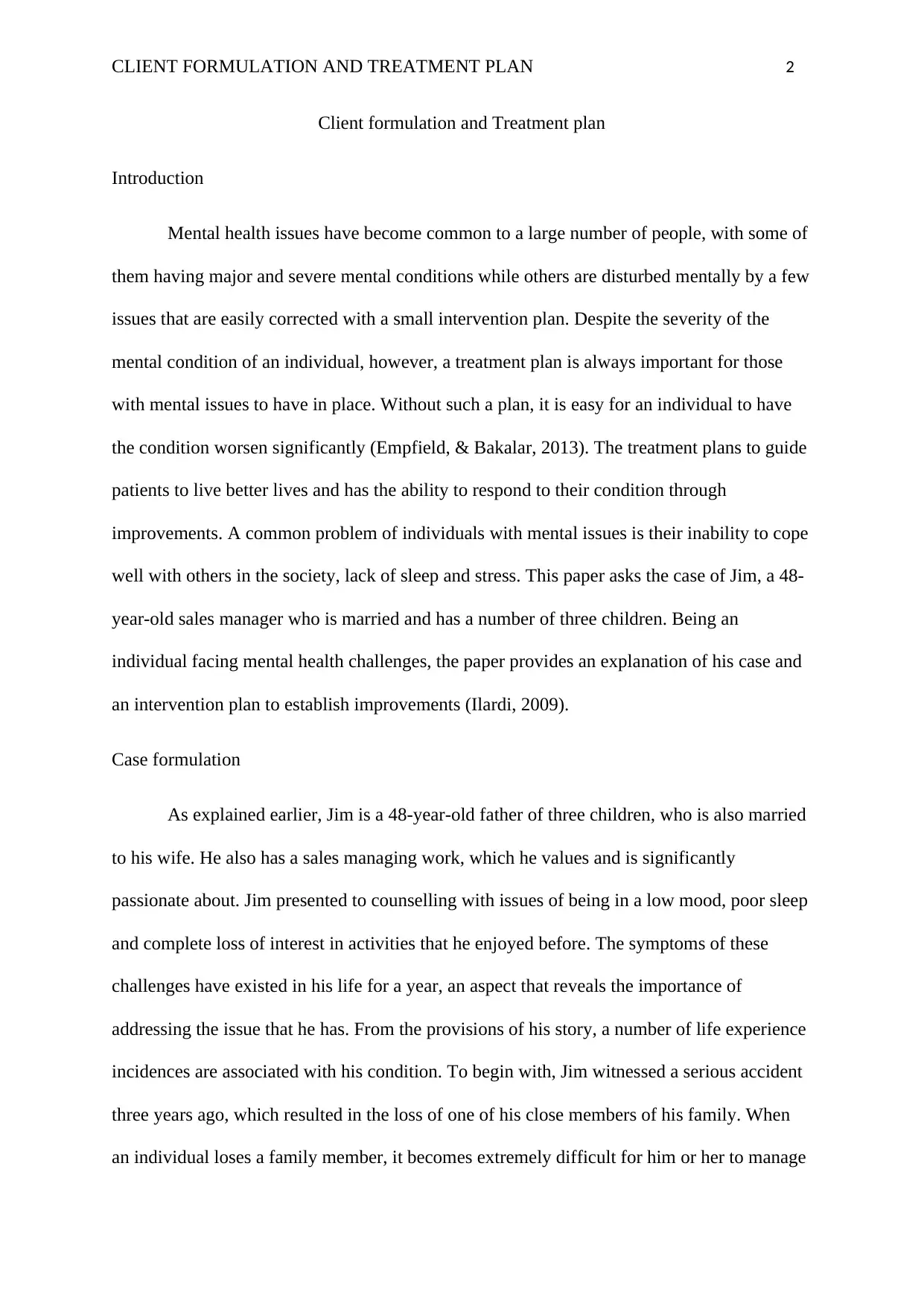
CLIENT FORMULATION AND TREATMENT PLAN 2
Client formulation and Treatment plan
Introduction
Mental health issues have become common to a large number of people, with some of
them having major and severe mental conditions while others are disturbed mentally by a few
issues that are easily corrected with a small intervention plan. Despite the severity of the
mental condition of an individual, however, a treatment plan is always important for those
with mental issues to have in place. Without such a plan, it is easy for an individual to have
the condition worsen significantly (Empfield, & Bakalar, 2013). The treatment plans to guide
patients to live better lives and has the ability to respond to their condition through
improvements. A common problem of individuals with mental issues is their inability to cope
well with others in the society, lack of sleep and stress. This paper asks the case of Jim, a 48-
year-old sales manager who is married and has a number of three children. Being an
individual facing mental health challenges, the paper provides an explanation of his case and
an intervention plan to establish improvements (Ilardi, 2009).
Case formulation
As explained earlier, Jim is a 48-year-old father of three children, who is also married
to his wife. He also has a sales managing work, which he values and is significantly
passionate about. Jim presented to counselling with issues of being in a low mood, poor sleep
and complete loss of interest in activities that he enjoyed before. The symptoms of these
challenges have existed in his life for a year, an aspect that reveals the importance of
addressing the issue that he has. From the provisions of his story, a number of life experience
incidences are associated with his condition. To begin with, Jim witnessed a serious accident
three years ago, which resulted in the loss of one of his close members of his family. When
an individual loses a family member, it becomes extremely difficult for him or her to manage
Client formulation and Treatment plan
Introduction
Mental health issues have become common to a large number of people, with some of
them having major and severe mental conditions while others are disturbed mentally by a few
issues that are easily corrected with a small intervention plan. Despite the severity of the
mental condition of an individual, however, a treatment plan is always important for those
with mental issues to have in place. Without such a plan, it is easy for an individual to have
the condition worsen significantly (Empfield, & Bakalar, 2013). The treatment plans to guide
patients to live better lives and has the ability to respond to their condition through
improvements. A common problem of individuals with mental issues is their inability to cope
well with others in the society, lack of sleep and stress. This paper asks the case of Jim, a 48-
year-old sales manager who is married and has a number of three children. Being an
individual facing mental health challenges, the paper provides an explanation of his case and
an intervention plan to establish improvements (Ilardi, 2009).
Case formulation
As explained earlier, Jim is a 48-year-old father of three children, who is also married
to his wife. He also has a sales managing work, which he values and is significantly
passionate about. Jim presented to counselling with issues of being in a low mood, poor sleep
and complete loss of interest in activities that he enjoyed before. The symptoms of these
challenges have existed in his life for a year, an aspect that reveals the importance of
addressing the issue that he has. From the provisions of his story, a number of life experience
incidences are associated with his condition. To begin with, Jim witnessed a serious accident
three years ago, which resulted in the loss of one of his close members of his family. When
an individual loses a family member, it becomes extremely difficult for him or her to manage
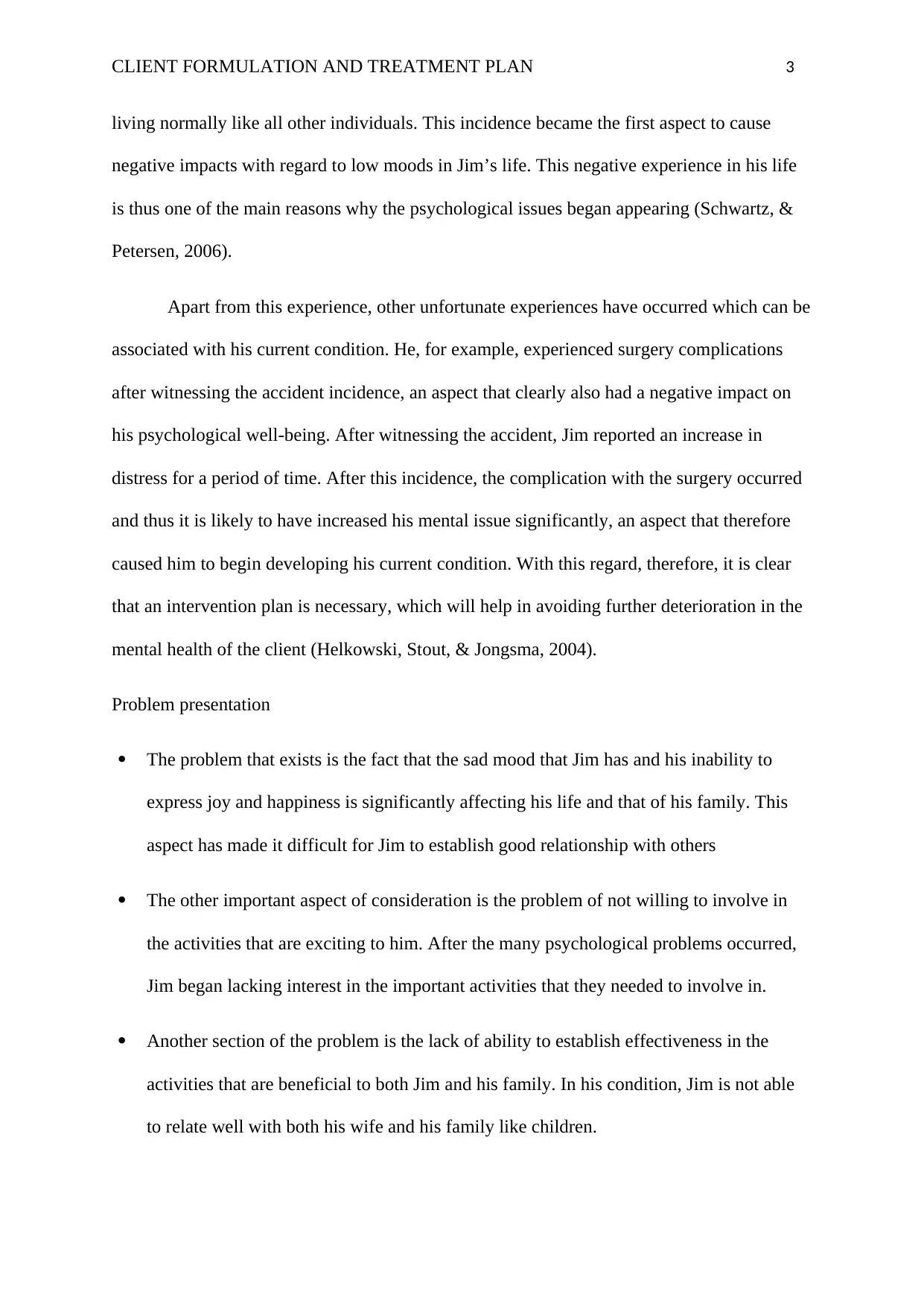
CLIENT FORMULATION AND TREATMENT PLAN 3
living normally like all other individuals. This incidence became the first aspect to cause
negative impacts with regard to low moods in Jim’s life. This negative experience in his life
is thus one of the main reasons why the psychological issues began appearing (Schwartz, &
Petersen, 2006).
Apart from this experience, other unfortunate experiences have occurred which can be
associated with his current condition. He, for example, experienced surgery complications
after witnessing the accident incidence, an aspect that clearly also had a negative impact on
his psychological well-being. After witnessing the accident, Jim reported an increase in
distress for a period of time. After this incidence, the complication with the surgery occurred
and thus it is likely to have increased his mental issue significantly, an aspect that therefore
caused him to begin developing his current condition. With this regard, therefore, it is clear
that an intervention plan is necessary, which will help in avoiding further deterioration in the
mental health of the client (Helkowski, Stout, & Jongsma, 2004).
Problem presentation
The problem that exists is the fact that the sad mood that Jim has and his inability to
express joy and happiness is significantly affecting his life and that of his family. This
aspect has made it difficult for Jim to establish good relationship with others
The other important aspect of consideration is the problem of not willing to involve in
the activities that are exciting to him. After the many psychological problems occurred,
Jim began lacking interest in the important activities that they needed to involve in.
Another section of the problem is the lack of ability to establish effectiveness in the
activities that are beneficial to both Jim and his family. In his condition, Jim is not able
to relate well with both his wife and his family like children.
living normally like all other individuals. This incidence became the first aspect to cause
negative impacts with regard to low moods in Jim’s life. This negative experience in his life
is thus one of the main reasons why the psychological issues began appearing (Schwartz, &
Petersen, 2006).
Apart from this experience, other unfortunate experiences have occurred which can be
associated with his current condition. He, for example, experienced surgery complications
after witnessing the accident incidence, an aspect that clearly also had a negative impact on
his psychological well-being. After witnessing the accident, Jim reported an increase in
distress for a period of time. After this incidence, the complication with the surgery occurred
and thus it is likely to have increased his mental issue significantly, an aspect that therefore
caused him to begin developing his current condition. With this regard, therefore, it is clear
that an intervention plan is necessary, which will help in avoiding further deterioration in the
mental health of the client (Helkowski, Stout, & Jongsma, 2004).
Problem presentation
The problem that exists is the fact that the sad mood that Jim has and his inability to
express joy and happiness is significantly affecting his life and that of his family. This
aspect has made it difficult for Jim to establish good relationship with others
The other important aspect of consideration is the problem of not willing to involve in
the activities that are exciting to him. After the many psychological problems occurred,
Jim began lacking interest in the important activities that they needed to involve in.
Another section of the problem is the lack of ability to establish effectiveness in the
activities that are beneficial to both Jim and his family. In his condition, Jim is not able
to relate well with both his wife and his family like children.
⊘ This is a preview!⊘
Do you want full access?
Subscribe today to unlock all pages.

Trusted by 1+ million students worldwide
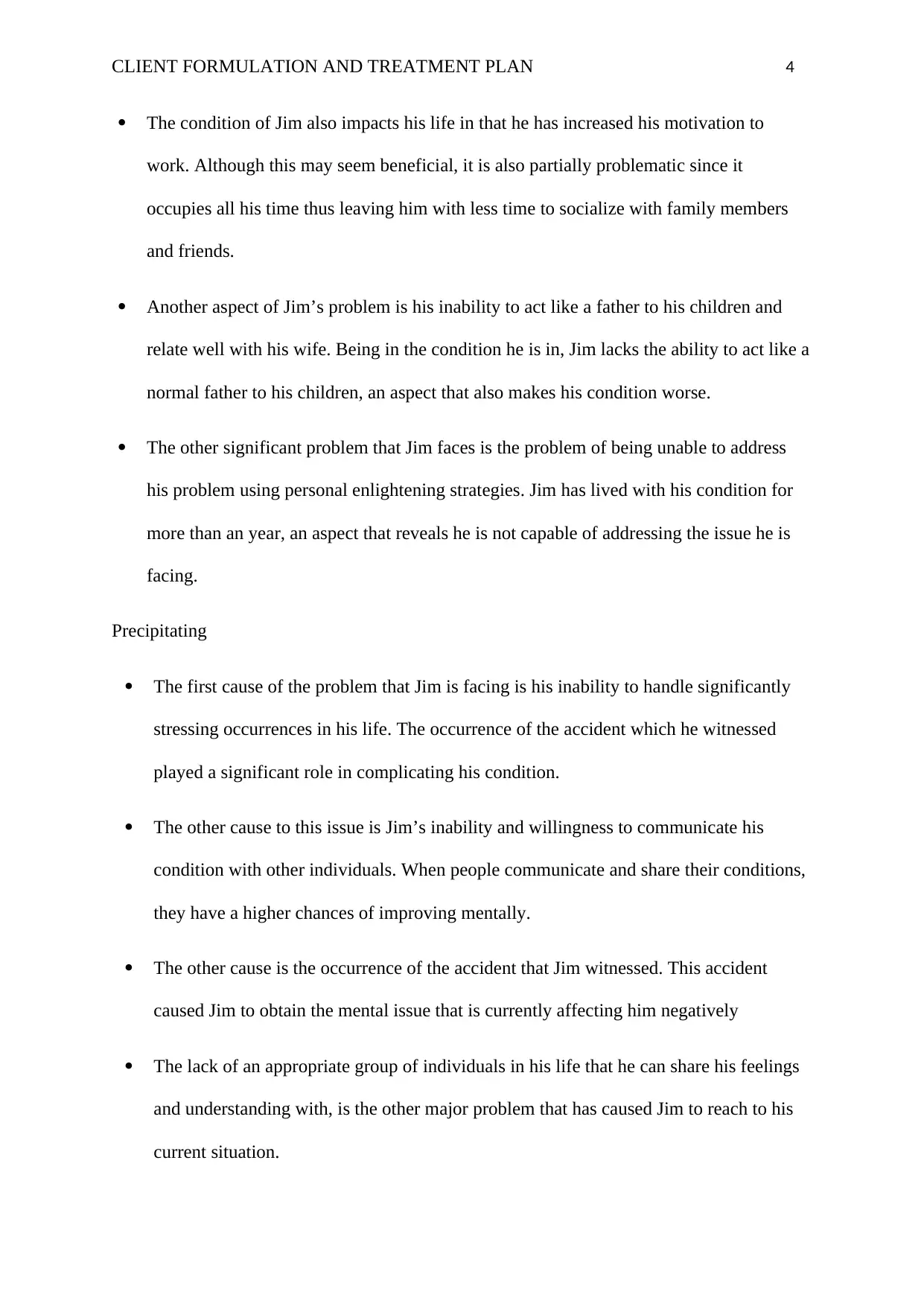
CLIENT FORMULATION AND TREATMENT PLAN 4
The condition of Jim also impacts his life in that he has increased his motivation to
work. Although this may seem beneficial, it is also partially problematic since it
occupies all his time thus leaving him with less time to socialize with family members
and friends.
Another aspect of Jim’s problem is his inability to act like a father to his children and
relate well with his wife. Being in the condition he is in, Jim lacks the ability to act like a
normal father to his children, an aspect that also makes his condition worse.
The other significant problem that Jim faces is the problem of being unable to address
his problem using personal enlightening strategies. Jim has lived with his condition for
more than an year, an aspect that reveals he is not capable of addressing the issue he is
facing.
Precipitating
The first cause of the problem that Jim is facing is his inability to handle significantly
stressing occurrences in his life. The occurrence of the accident which he witnessed
played a significant role in complicating his condition.
The other cause to this issue is Jim’s inability and willingness to communicate his
condition with other individuals. When people communicate and share their conditions,
they have a higher chances of improving mentally.
The other cause is the occurrence of the accident that Jim witnessed. This accident
caused Jim to obtain the mental issue that is currently affecting him negatively
The lack of an appropriate group of individuals in his life that he can share his feelings
and understanding with, is the other major problem that has caused Jim to reach to his
current situation.
The condition of Jim also impacts his life in that he has increased his motivation to
work. Although this may seem beneficial, it is also partially problematic since it
occupies all his time thus leaving him with less time to socialize with family members
and friends.
Another aspect of Jim’s problem is his inability to act like a father to his children and
relate well with his wife. Being in the condition he is in, Jim lacks the ability to act like a
normal father to his children, an aspect that also makes his condition worse.
The other significant problem that Jim faces is the problem of being unable to address
his problem using personal enlightening strategies. Jim has lived with his condition for
more than an year, an aspect that reveals he is not capable of addressing the issue he is
facing.
Precipitating
The first cause of the problem that Jim is facing is his inability to handle significantly
stressing occurrences in his life. The occurrence of the accident which he witnessed
played a significant role in complicating his condition.
The other cause to this issue is Jim’s inability and willingness to communicate his
condition with other individuals. When people communicate and share their conditions,
they have a higher chances of improving mentally.
The other cause is the occurrence of the accident that Jim witnessed. This accident
caused Jim to obtain the mental issue that is currently affecting him negatively
The lack of an appropriate group of individuals in his life that he can share his feelings
and understanding with, is the other major problem that has caused Jim to reach to his
current situation.
Paraphrase This Document
Need a fresh take? Get an instant paraphrase of this document with our AI Paraphraser
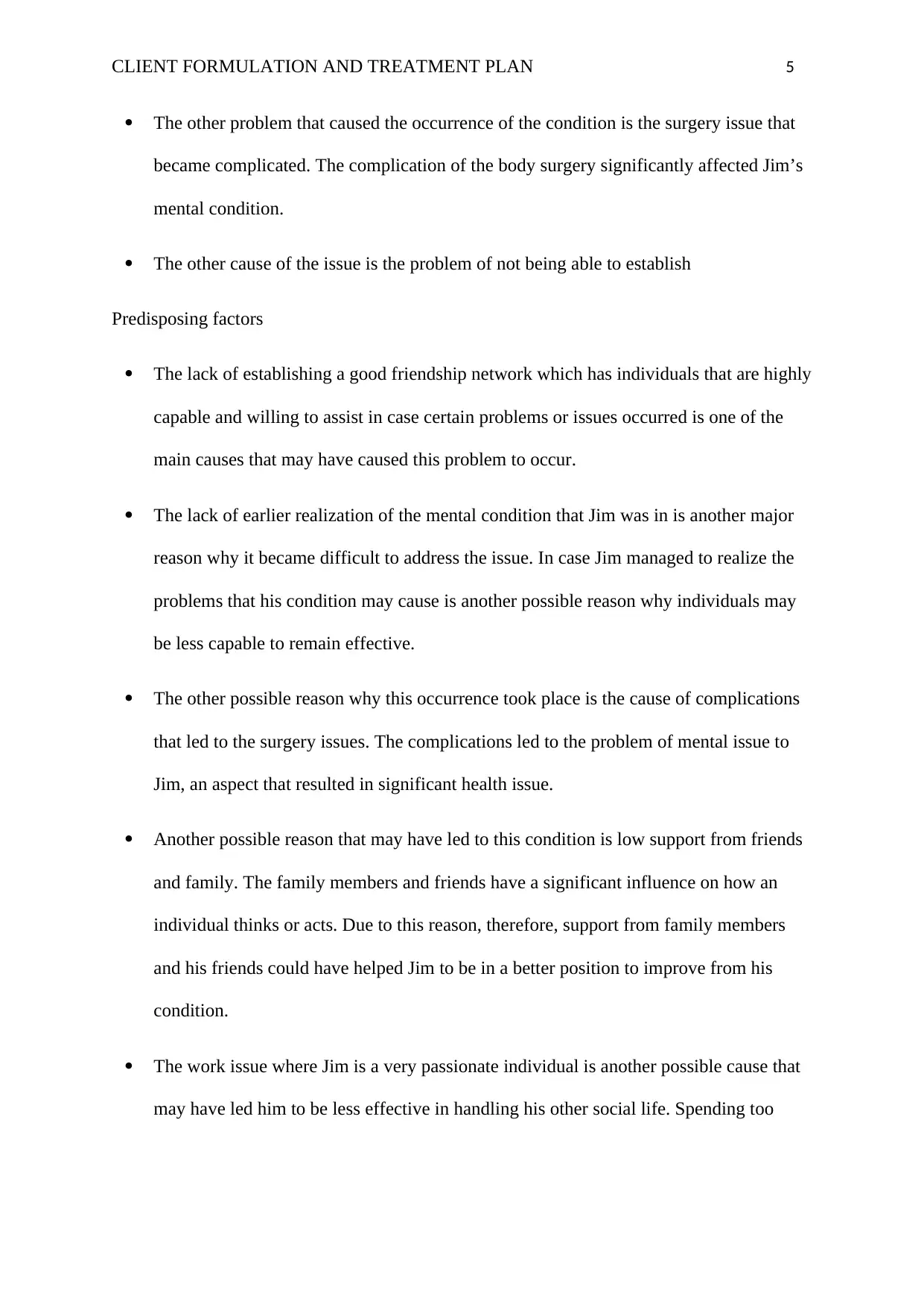
CLIENT FORMULATION AND TREATMENT PLAN 5
The other problem that caused the occurrence of the condition is the surgery issue that
became complicated. The complication of the body surgery significantly affected Jim’s
mental condition.
The other cause of the issue is the problem of not being able to establish
Predisposing factors
The lack of establishing a good friendship network which has individuals that are highly
capable and willing to assist in case certain problems or issues occurred is one of the
main causes that may have caused this problem to occur.
The lack of earlier realization of the mental condition that Jim was in is another major
reason why it became difficult to address the issue. In case Jim managed to realize the
problems that his condition may cause is another possible reason why individuals may
be less capable to remain effective.
The other possible reason why this occurrence took place is the cause of complications
that led to the surgery issues. The complications led to the problem of mental issue to
Jim, an aspect that resulted in significant health issue.
Another possible reason that may have led to this condition is low support from friends
and family. The family members and friends have a significant influence on how an
individual thinks or acts. Due to this reason, therefore, support from family members
and his friends could have helped Jim to be in a better position to improve from his
condition.
The work issue where Jim is a very passionate individual is another possible cause that
may have led him to be less effective in handling his other social life. Spending too
The other problem that caused the occurrence of the condition is the surgery issue that
became complicated. The complication of the body surgery significantly affected Jim’s
mental condition.
The other cause of the issue is the problem of not being able to establish
Predisposing factors
The lack of establishing a good friendship network which has individuals that are highly
capable and willing to assist in case certain problems or issues occurred is one of the
main causes that may have caused this problem to occur.
The lack of earlier realization of the mental condition that Jim was in is another major
reason why it became difficult to address the issue. In case Jim managed to realize the
problems that his condition may cause is another possible reason why individuals may
be less capable to remain effective.
The other possible reason why this occurrence took place is the cause of complications
that led to the surgery issues. The complications led to the problem of mental issue to
Jim, an aspect that resulted in significant health issue.
Another possible reason that may have led to this condition is low support from friends
and family. The family members and friends have a significant influence on how an
individual thinks or acts. Due to this reason, therefore, support from family members
and his friends could have helped Jim to be in a better position to improve from his
condition.
The work issue where Jim is a very passionate individual is another possible cause that
may have led him to be less effective in handling his other social life. Spending too
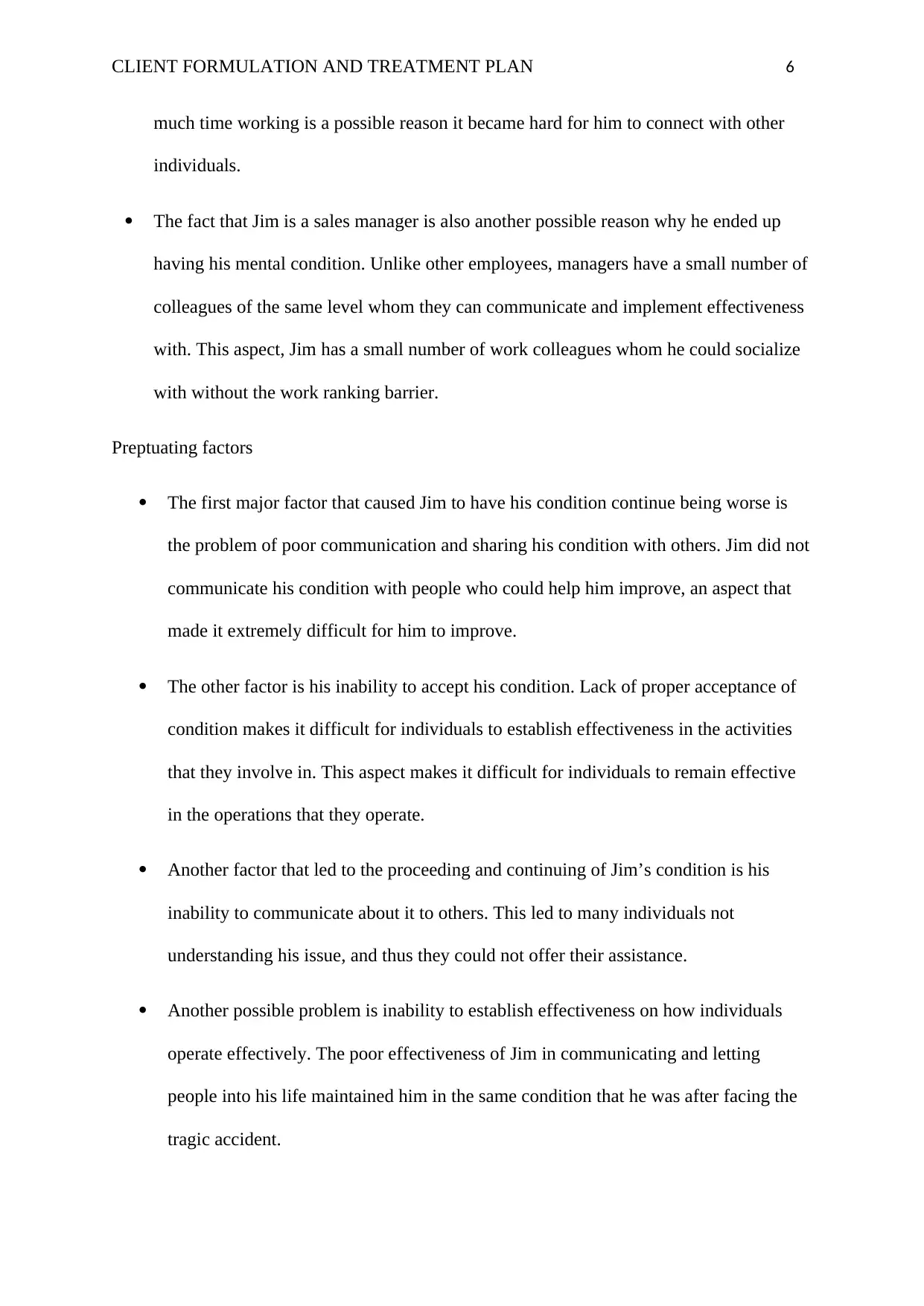
CLIENT FORMULATION AND TREATMENT PLAN 6
much time working is a possible reason it became hard for him to connect with other
individuals.
The fact that Jim is a sales manager is also another possible reason why he ended up
having his mental condition. Unlike other employees, managers have a small number of
colleagues of the same level whom they can communicate and implement effectiveness
with. This aspect, Jim has a small number of work colleagues whom he could socialize
with without the work ranking barrier.
Preptuating factors
The first major factor that caused Jim to have his condition continue being worse is
the problem of poor communication and sharing his condition with others. Jim did not
communicate his condition with people who could help him improve, an aspect that
made it extremely difficult for him to improve.
The other factor is his inability to accept his condition. Lack of proper acceptance of
condition makes it difficult for individuals to establish effectiveness in the activities
that they involve in. This aspect makes it difficult for individuals to remain effective
in the operations that they operate.
Another factor that led to the proceeding and continuing of Jim’s condition is his
inability to communicate about it to others. This led to many individuals not
understanding his issue, and thus they could not offer their assistance.
Another possible problem is inability to establish effectiveness on how individuals
operate effectively. The poor effectiveness of Jim in communicating and letting
people into his life maintained him in the same condition that he was after facing the
tragic accident.
much time working is a possible reason it became hard for him to connect with other
individuals.
The fact that Jim is a sales manager is also another possible reason why he ended up
having his mental condition. Unlike other employees, managers have a small number of
colleagues of the same level whom they can communicate and implement effectiveness
with. This aspect, Jim has a small number of work colleagues whom he could socialize
with without the work ranking barrier.
Preptuating factors
The first major factor that caused Jim to have his condition continue being worse is
the problem of poor communication and sharing his condition with others. Jim did not
communicate his condition with people who could help him improve, an aspect that
made it extremely difficult for him to improve.
The other factor is his inability to accept his condition. Lack of proper acceptance of
condition makes it difficult for individuals to establish effectiveness in the activities
that they involve in. This aspect makes it difficult for individuals to remain effective
in the operations that they operate.
Another factor that led to the proceeding and continuing of Jim’s condition is his
inability to communicate about it to others. This led to many individuals not
understanding his issue, and thus they could not offer their assistance.
Another possible problem is inability to establish effectiveness on how individuals
operate effectively. The poor effectiveness of Jim in communicating and letting
people into his life maintained him in the same condition that he was after facing the
tragic accident.
⊘ This is a preview!⊘
Do you want full access?
Subscribe today to unlock all pages.

Trusted by 1+ million students worldwide
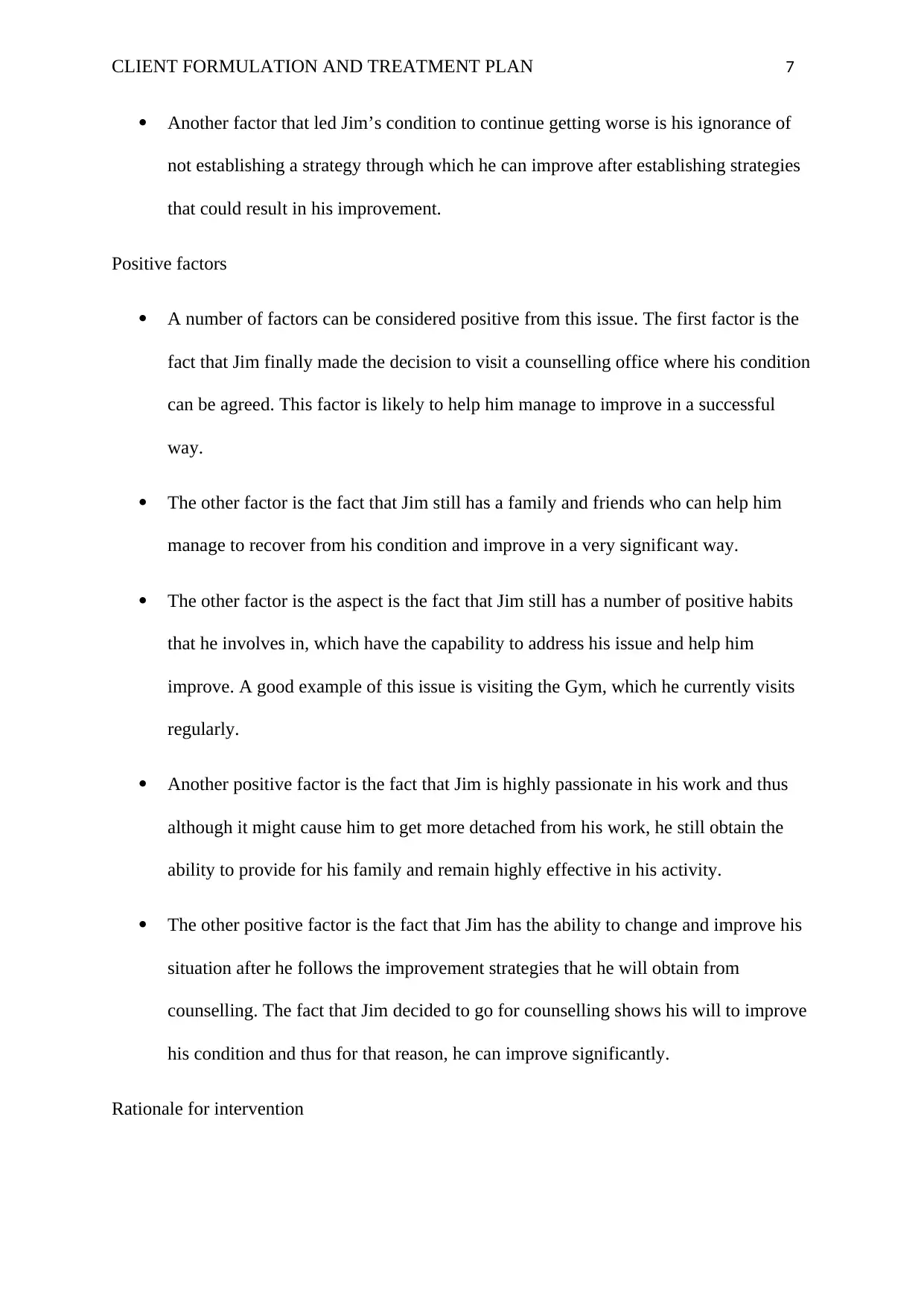
CLIENT FORMULATION AND TREATMENT PLAN 7
Another factor that led Jim’s condition to continue getting worse is his ignorance of
not establishing a strategy through which he can improve after establishing strategies
that could result in his improvement.
Positive factors
A number of factors can be considered positive from this issue. The first factor is the
fact that Jim finally made the decision to visit a counselling office where his condition
can be agreed. This factor is likely to help him manage to improve in a successful
way.
The other factor is the fact that Jim still has a family and friends who can help him
manage to recover from his condition and improve in a very significant way.
The other factor is the aspect is the fact that Jim still has a number of positive habits
that he involves in, which have the capability to address his issue and help him
improve. A good example of this issue is visiting the Gym, which he currently visits
regularly.
Another positive factor is the fact that Jim is highly passionate in his work and thus
although it might cause him to get more detached from his work, he still obtain the
ability to provide for his family and remain highly effective in his activity.
The other positive factor is the fact that Jim has the ability to change and improve his
situation after he follows the improvement strategies that he will obtain from
counselling. The fact that Jim decided to go for counselling shows his will to improve
his condition and thus for that reason, he can improve significantly.
Rationale for intervention
Another factor that led Jim’s condition to continue getting worse is his ignorance of
not establishing a strategy through which he can improve after establishing strategies
that could result in his improvement.
Positive factors
A number of factors can be considered positive from this issue. The first factor is the
fact that Jim finally made the decision to visit a counselling office where his condition
can be agreed. This factor is likely to help him manage to improve in a successful
way.
The other factor is the fact that Jim still has a family and friends who can help him
manage to recover from his condition and improve in a very significant way.
The other factor is the aspect is the fact that Jim still has a number of positive habits
that he involves in, which have the capability to address his issue and help him
improve. A good example of this issue is visiting the Gym, which he currently visits
regularly.
Another positive factor is the fact that Jim is highly passionate in his work and thus
although it might cause him to get more detached from his work, he still obtain the
ability to provide for his family and remain highly effective in his activity.
The other positive factor is the fact that Jim has the ability to change and improve his
situation after he follows the improvement strategies that he will obtain from
counselling. The fact that Jim decided to go for counselling shows his will to improve
his condition and thus for that reason, he can improve significantly.
Rationale for intervention
Paraphrase This Document
Need a fresh take? Get an instant paraphrase of this document with our AI Paraphraser
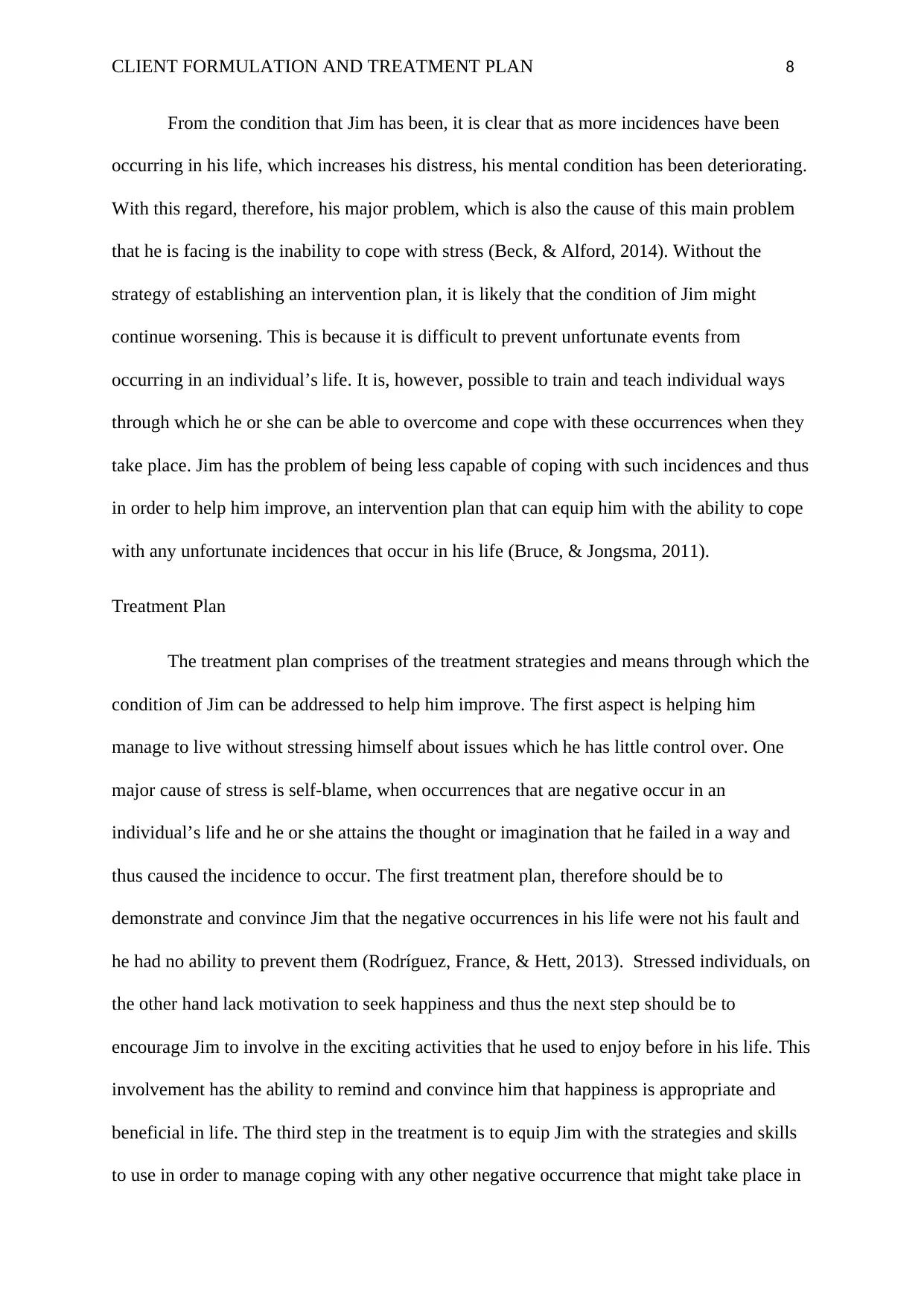
CLIENT FORMULATION AND TREATMENT PLAN 8
From the condition that Jim has been, it is clear that as more incidences have been
occurring in his life, which increases his distress, his mental condition has been deteriorating.
With this regard, therefore, his major problem, which is also the cause of this main problem
that he is facing is the inability to cope with stress (Beck, & Alford, 2014). Without the
strategy of establishing an intervention plan, it is likely that the condition of Jim might
continue worsening. This is because it is difficult to prevent unfortunate events from
occurring in an individual’s life. It is, however, possible to train and teach individual ways
through which he or she can be able to overcome and cope with these occurrences when they
take place. Jim has the problem of being less capable of coping with such incidences and thus
in order to help him improve, an intervention plan that can equip him with the ability to cope
with any unfortunate incidences that occur in his life (Bruce, & Jongsma, 2011).
Treatment Plan
The treatment plan comprises of the treatment strategies and means through which the
condition of Jim can be addressed to help him improve. The first aspect is helping him
manage to live without stressing himself about issues which he has little control over. One
major cause of stress is self-blame, when occurrences that are negative occur in an
individual’s life and he or she attains the thought or imagination that he failed in a way and
thus caused the incidence to occur. The first treatment plan, therefore should be to
demonstrate and convince Jim that the negative occurrences in his life were not his fault and
he had no ability to prevent them (Rodríguez, France, & Hett, 2013). Stressed individuals, on
the other hand lack motivation to seek happiness and thus the next step should be to
encourage Jim to involve in the exciting activities that he used to enjoy before in his life. This
involvement has the ability to remind and convince him that happiness is appropriate and
beneficial in life. The third step in the treatment is to equip Jim with the strategies and skills
to use in order to manage coping with any other negative occurrence that might take place in
From the condition that Jim has been, it is clear that as more incidences have been
occurring in his life, which increases his distress, his mental condition has been deteriorating.
With this regard, therefore, his major problem, which is also the cause of this main problem
that he is facing is the inability to cope with stress (Beck, & Alford, 2014). Without the
strategy of establishing an intervention plan, it is likely that the condition of Jim might
continue worsening. This is because it is difficult to prevent unfortunate events from
occurring in an individual’s life. It is, however, possible to train and teach individual ways
through which he or she can be able to overcome and cope with these occurrences when they
take place. Jim has the problem of being less capable of coping with such incidences and thus
in order to help him improve, an intervention plan that can equip him with the ability to cope
with any unfortunate incidences that occur in his life (Bruce, & Jongsma, 2011).
Treatment Plan
The treatment plan comprises of the treatment strategies and means through which the
condition of Jim can be addressed to help him improve. The first aspect is helping him
manage to live without stressing himself about issues which he has little control over. One
major cause of stress is self-blame, when occurrences that are negative occur in an
individual’s life and he or she attains the thought or imagination that he failed in a way and
thus caused the incidence to occur. The first treatment plan, therefore should be to
demonstrate and convince Jim that the negative occurrences in his life were not his fault and
he had no ability to prevent them (Rodríguez, France, & Hett, 2013). Stressed individuals, on
the other hand lack motivation to seek happiness and thus the next step should be to
encourage Jim to involve in the exciting activities that he used to enjoy before in his life. This
involvement has the ability to remind and convince him that happiness is appropriate and
beneficial in life. The third step in the treatment is to equip Jim with the strategies and skills
to use in order to manage coping with any other negative occurrence that might take place in
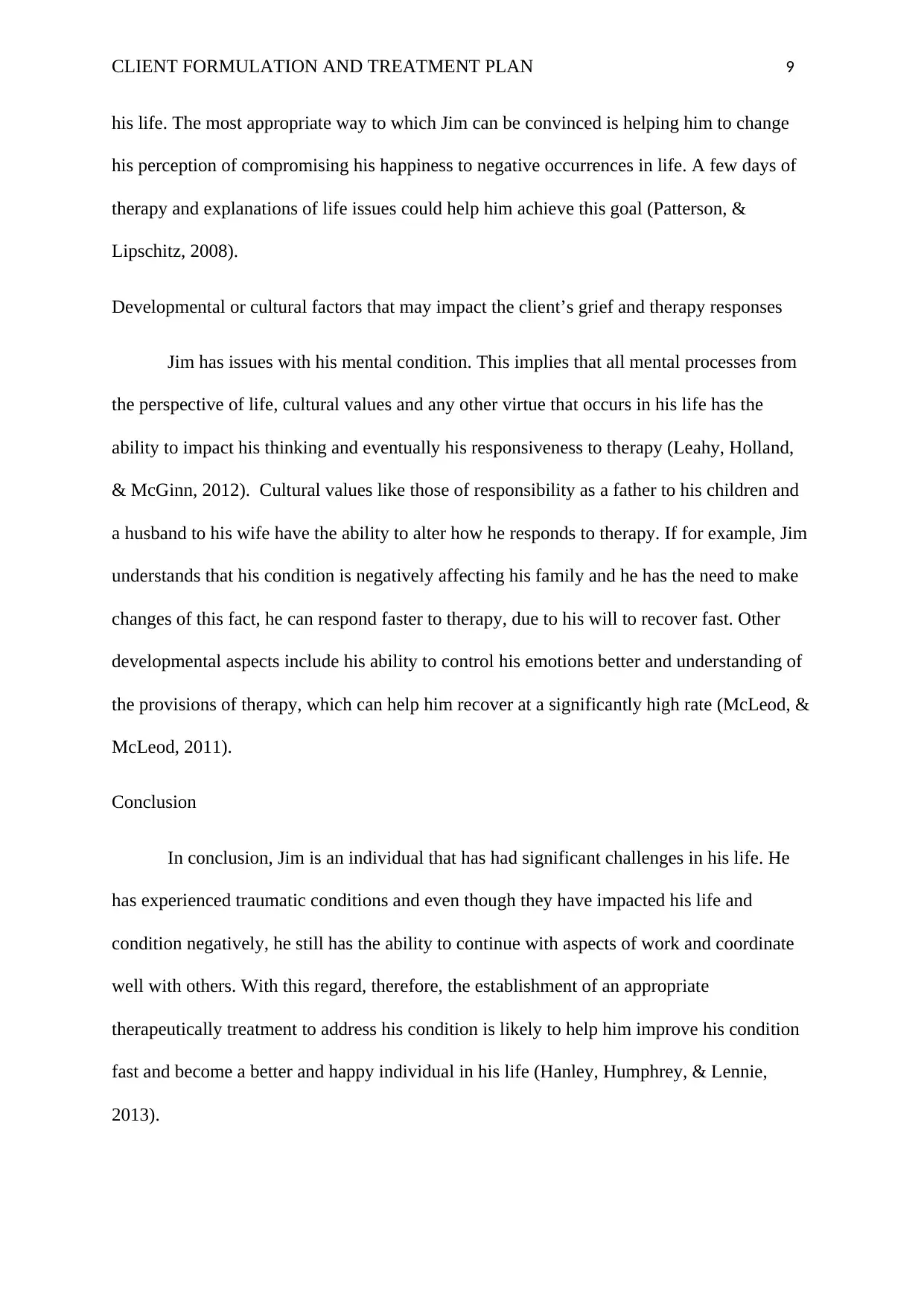
CLIENT FORMULATION AND TREATMENT PLAN 9
his life. The most appropriate way to which Jim can be convinced is helping him to change
his perception of compromising his happiness to negative occurrences in life. A few days of
therapy and explanations of life issues could help him achieve this goal (Patterson, &
Lipschitz, 2008).
Developmental or cultural factors that may impact the client’s grief and therapy responses
Jim has issues with his mental condition. This implies that all mental processes from
the perspective of life, cultural values and any other virtue that occurs in his life has the
ability to impact his thinking and eventually his responsiveness to therapy (Leahy, Holland,
& McGinn, 2012). Cultural values like those of responsibility as a father to his children and
a husband to his wife have the ability to alter how he responds to therapy. If for example, Jim
understands that his condition is negatively affecting his family and he has the need to make
changes of this fact, he can respond faster to therapy, due to his will to recover fast. Other
developmental aspects include his ability to control his emotions better and understanding of
the provisions of therapy, which can help him recover at a significantly high rate (McLeod, &
McLeod, 2011).
Conclusion
In conclusion, Jim is an individual that has had significant challenges in his life. He
has experienced traumatic conditions and even though they have impacted his life and
condition negatively, he still has the ability to continue with aspects of work and coordinate
well with others. With this regard, therefore, the establishment of an appropriate
therapeutically treatment to address his condition is likely to help him improve his condition
fast and become a better and happy individual in his life (Hanley, Humphrey, & Lennie,
2013).
his life. The most appropriate way to which Jim can be convinced is helping him to change
his perception of compromising his happiness to negative occurrences in life. A few days of
therapy and explanations of life issues could help him achieve this goal (Patterson, &
Lipschitz, 2008).
Developmental or cultural factors that may impact the client’s grief and therapy responses
Jim has issues with his mental condition. This implies that all mental processes from
the perspective of life, cultural values and any other virtue that occurs in his life has the
ability to impact his thinking and eventually his responsiveness to therapy (Leahy, Holland,
& McGinn, 2012). Cultural values like those of responsibility as a father to his children and
a husband to his wife have the ability to alter how he responds to therapy. If for example, Jim
understands that his condition is negatively affecting his family and he has the need to make
changes of this fact, he can respond faster to therapy, due to his will to recover fast. Other
developmental aspects include his ability to control his emotions better and understanding of
the provisions of therapy, which can help him recover at a significantly high rate (McLeod, &
McLeod, 2011).
Conclusion
In conclusion, Jim is an individual that has had significant challenges in his life. He
has experienced traumatic conditions and even though they have impacted his life and
condition negatively, he still has the ability to continue with aspects of work and coordinate
well with others. With this regard, therefore, the establishment of an appropriate
therapeutically treatment to address his condition is likely to help him improve his condition
fast and become a better and happy individual in his life (Hanley, Humphrey, & Lennie,
2013).
⊘ This is a preview!⊘
Do you want full access?
Subscribe today to unlock all pages.

Trusted by 1+ million students worldwide
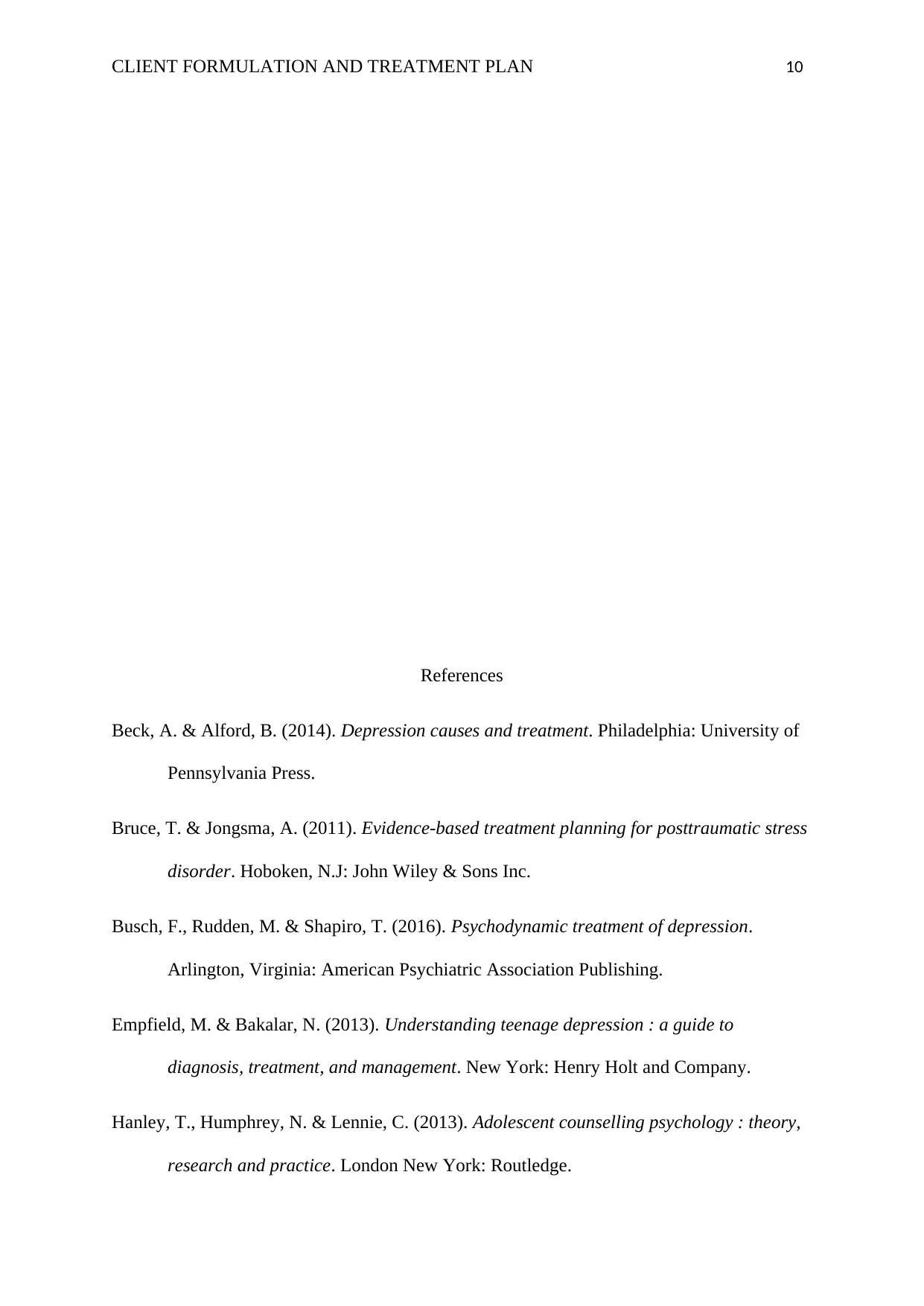
CLIENT FORMULATION AND TREATMENT PLAN 10
References
Beck, A. & Alford, B. (2014). Depression causes and treatment. Philadelphia: University of
Pennsylvania Press.
Bruce, T. & Jongsma, A. (2011). Evidence-based treatment planning for posttraumatic stress
disorder. Hoboken, N.J: John Wiley & Sons Inc.
Busch, F., Rudden, M. & Shapiro, T. (2016). Psychodynamic treatment of depression.
Arlington, Virginia: American Psychiatric Association Publishing.
Empfield, M. & Bakalar, N. (2013). Understanding teenage depression : a guide to
diagnosis, treatment, and management. New York: Henry Holt and Company.
Hanley, T., Humphrey, N. & Lennie, C. (2013). Adolescent counselling psychology : theory,
research and practice. London New York: Routledge.
References
Beck, A. & Alford, B. (2014). Depression causes and treatment. Philadelphia: University of
Pennsylvania Press.
Bruce, T. & Jongsma, A. (2011). Evidence-based treatment planning for posttraumatic stress
disorder. Hoboken, N.J: John Wiley & Sons Inc.
Busch, F., Rudden, M. & Shapiro, T. (2016). Psychodynamic treatment of depression.
Arlington, Virginia: American Psychiatric Association Publishing.
Empfield, M. & Bakalar, N. (2013). Understanding teenage depression : a guide to
diagnosis, treatment, and management. New York: Henry Holt and Company.
Hanley, T., Humphrey, N. & Lennie, C. (2013). Adolescent counselling psychology : theory,
research and practice. London New York: Routledge.
Paraphrase This Document
Need a fresh take? Get an instant paraphrase of this document with our AI Paraphraser
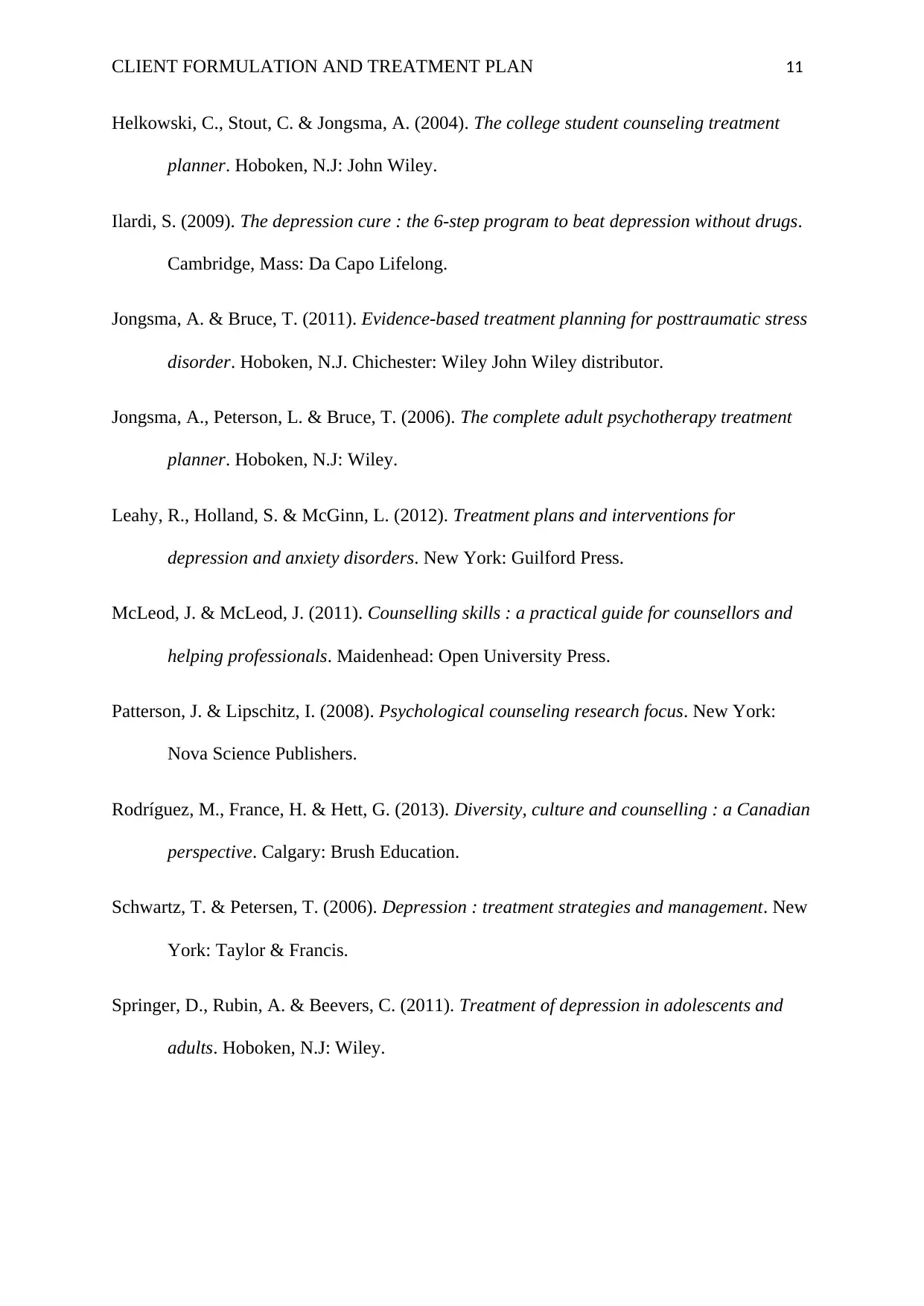
CLIENT FORMULATION AND TREATMENT PLAN 11
Helkowski, C., Stout, C. & Jongsma, A. (2004). The college student counseling treatment
planner. Hoboken, N.J: John Wiley.
Ilardi, S. (2009). The depression cure : the 6-step program to beat depression without drugs.
Cambridge, Mass: Da Capo Lifelong.
Jongsma, A. & Bruce, T. (2011). Evidence-based treatment planning for posttraumatic stress
disorder. Hoboken, N.J. Chichester: Wiley John Wiley distributor.
Jongsma, A., Peterson, L. & Bruce, T. (2006). The complete adult psychotherapy treatment
planner. Hoboken, N.J: Wiley.
Leahy, R., Holland, S. & McGinn, L. (2012). Treatment plans and interventions for
depression and anxiety disorders. New York: Guilford Press.
McLeod, J. & McLeod, J. (2011). Counselling skills : a practical guide for counsellors and
helping professionals. Maidenhead: Open University Press.
Patterson, J. & Lipschitz, I. (2008). Psychological counseling research focus. New York:
Nova Science Publishers.
Rodríguez, M., France, H. & Hett, G. (2013). Diversity, culture and counselling : a Canadian
perspective. Calgary: Brush Education.
Schwartz, T. & Petersen, T. (2006). Depression : treatment strategies and management. New
York: Taylor & Francis.
Springer, D., Rubin, A. & Beevers, C. (2011). Treatment of depression in adolescents and
adults. Hoboken, N.J: Wiley.
Helkowski, C., Stout, C. & Jongsma, A. (2004). The college student counseling treatment
planner. Hoboken, N.J: John Wiley.
Ilardi, S. (2009). The depression cure : the 6-step program to beat depression without drugs.
Cambridge, Mass: Da Capo Lifelong.
Jongsma, A. & Bruce, T. (2011). Evidence-based treatment planning for posttraumatic stress
disorder. Hoboken, N.J. Chichester: Wiley John Wiley distributor.
Jongsma, A., Peterson, L. & Bruce, T. (2006). The complete adult psychotherapy treatment
planner. Hoboken, N.J: Wiley.
Leahy, R., Holland, S. & McGinn, L. (2012). Treatment plans and interventions for
depression and anxiety disorders. New York: Guilford Press.
McLeod, J. & McLeod, J. (2011). Counselling skills : a practical guide for counsellors and
helping professionals. Maidenhead: Open University Press.
Patterson, J. & Lipschitz, I. (2008). Psychological counseling research focus. New York:
Nova Science Publishers.
Rodríguez, M., France, H. & Hett, G. (2013). Diversity, culture and counselling : a Canadian
perspective. Calgary: Brush Education.
Schwartz, T. & Petersen, T. (2006). Depression : treatment strategies and management. New
York: Taylor & Francis.
Springer, D., Rubin, A. & Beevers, C. (2011). Treatment of depression in adolescents and
adults. Hoboken, N.J: Wiley.

CLIENT FORMULATION AND TREATMENT PLAN 12
⊘ This is a preview!⊘
Do you want full access?
Subscribe today to unlock all pages.

Trusted by 1+ million students worldwide
1 out of 12
Related Documents
Your All-in-One AI-Powered Toolkit for Academic Success.
+13062052269
info@desklib.com
Available 24*7 on WhatsApp / Email
![[object Object]](/_next/static/media/star-bottom.7253800d.svg)
Unlock your academic potential
Copyright © 2020–2025 A2Z Services. All Rights Reserved. Developed and managed by ZUCOL.





